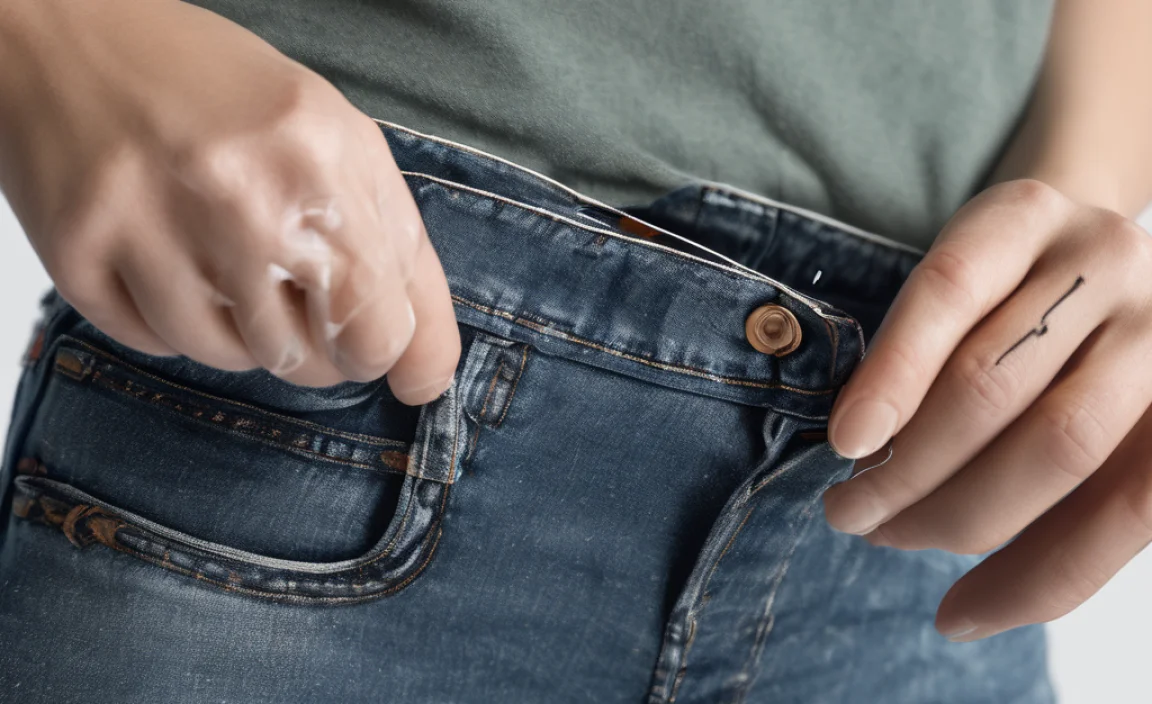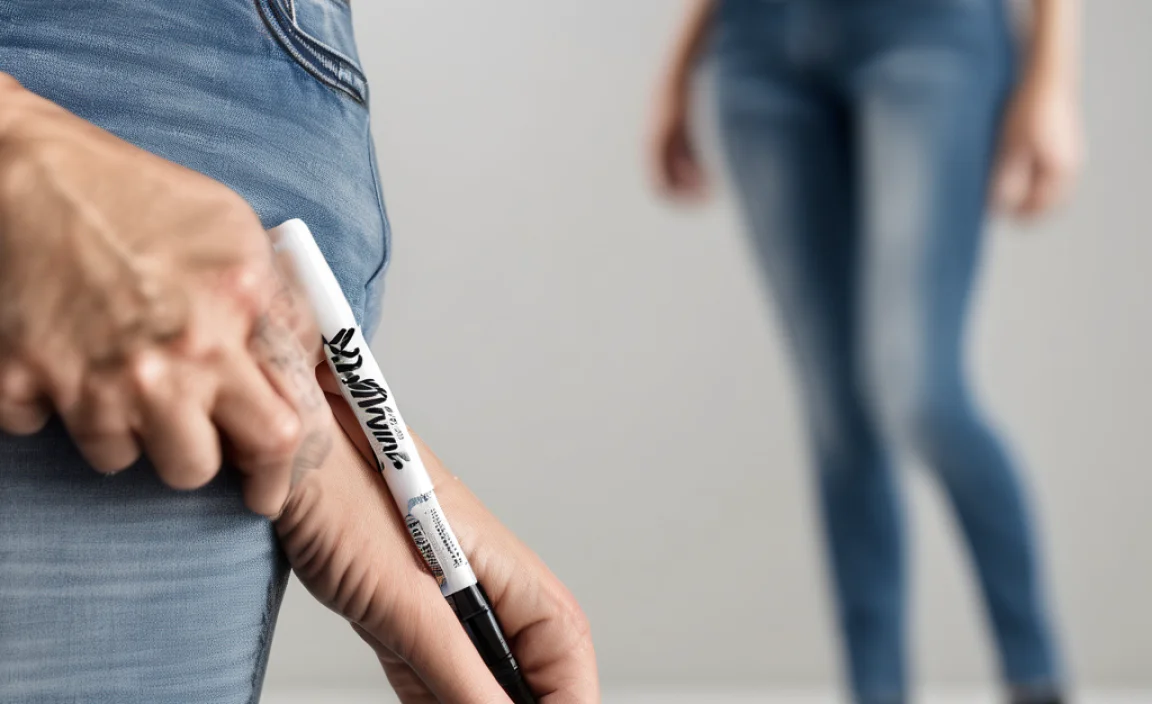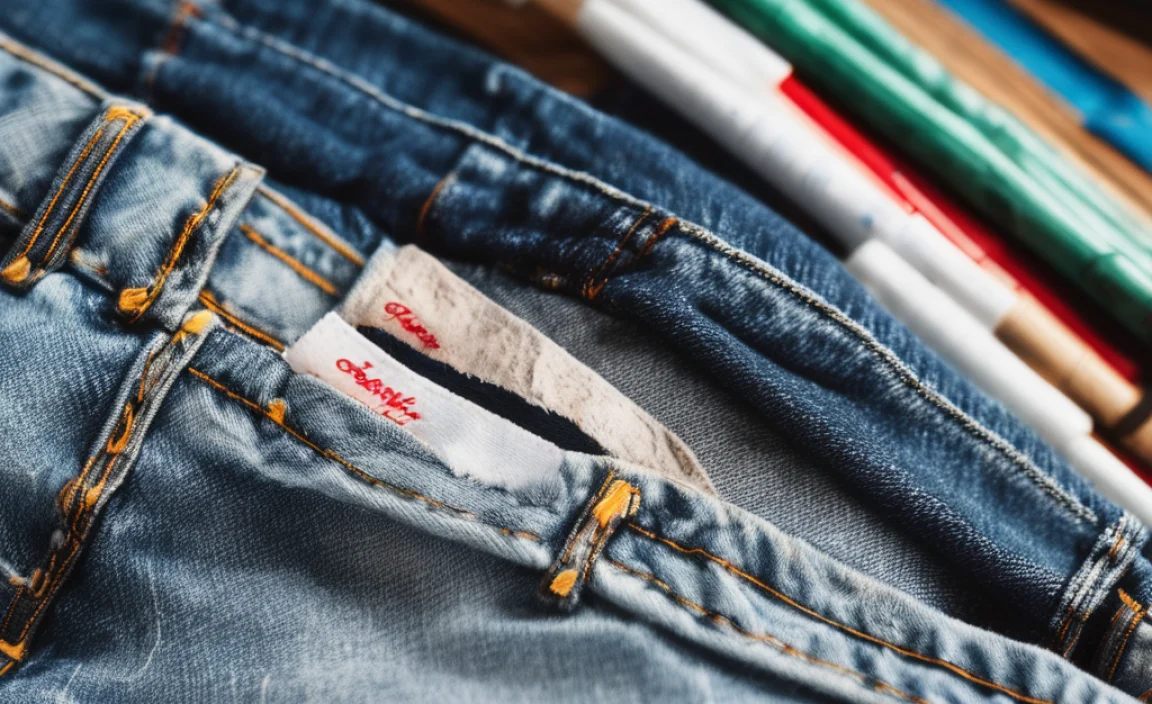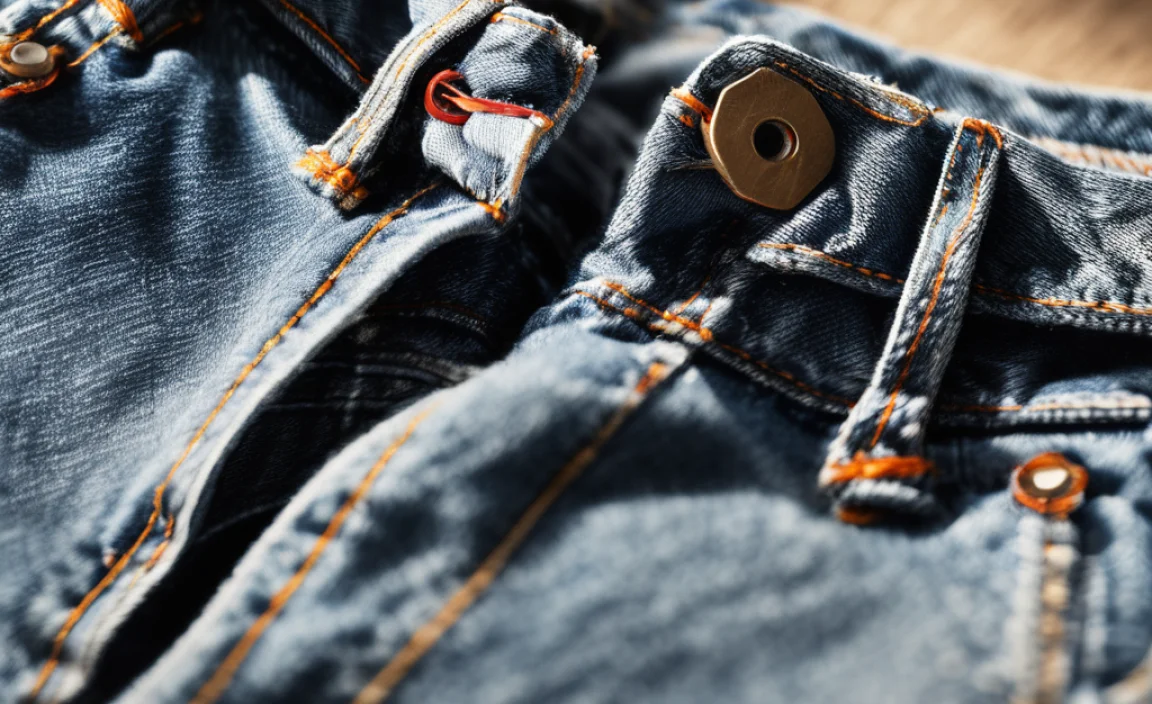Quick Summary: Accidentally marked your favorite jeans with Sharpie? Don’t panic! This guide offers proven, effective methods to lift that permanent ink, leaving your denim looking as good as new. We’ll cover tested solutions, from common household items to specialized removers, ensuring you can tackle this common clothing mishap with confidence.
Oh, the dreaded Sharpie incident! You reach for your favorite jeans, perhaps to jot down a quick note or doodle, and suddenly, there’s a streak of permanent marker right on the fabric. It happens to the best of us, whether it’s a stray mark from a pen cap or an accidental scribble. The good news is that a Sharpie stain on jeans doesn’t have to be a permanent disaster. With the right approach and a little patience, you can significantly diminish or even completely remove the ink. This guide will walk you through essential, proven methods to tackle this frustrating problem, making your jeans wearable again.
Understanding Sharpie Ink and Denim

Before we dive into removal methods, understanding what you’re up against is helpful. Sharpie ink is specifically designed to be permanent, meaning it contains solvents that help it bond strongly to surfaces, including fabric. Denim, while durable, is a woven cotton material that can absorb liquids rather quickly. The key to removing Sharpie from jeans lies in using substances that can break down the ink’s bond without damaging the denim fibers.
Different types of Sharpie ink exist, but for most common markers, the core components are pigments, resins, and solvents. The solvents are what allow the ink to spread and dry quickly, but they are also the part we aim to dissolve when trying to remove the stain. Denim’s weave can make the ink penetrate deeply, which is why immediate action is often best, though many methods can still work on older stains.
Essential Tools and Supplies for Sharpie Removal

Gathering your supplies before you start will make the process smoother. The exact items you’ll need will depend on the method you choose, but here’s a general list of what might come in handy:
- Clean white cloths or cotton balls
- Paper towels
- Rubbing alcohol (isopropyl alcohol)
- Hand sanitizer (containing at least 60% alcohol)
- Nail polish remover (non-oily, acetone-based is often best)
- Hairspray (aerosol, alcohol-based)
- White vinegar
- Baking soda
- Liquid laundry detergent
- Oxygen-based bleach (like OxiClean)
- Enzyme-based stain remover (specifically for ink or tough stains)
- A soft-bristled brush or old toothbrush
- A clean, dry towel or placemat to place underneath the stained area
- Gloves (optional, to protect your hands)
Method 1: Rubbing Alcohol – The Go-To Solution

Rubbing alcohol is often the first line of defense for Sharpie stains on fabric. Its strong solvent properties can effectively break down the ink. This method is generally safe for most denim washes, but it’s always wise to test on an inconspicuous area first, like an inside seam.
Step-by-Step Guide: Using Rubbing Alcohol
- Prepare the Area: Place a clean white cloth or a stack of paper towels directly underneath the stained section of the jeans. This is crucial to prevent the ink from transferring to another part of the garment as it lifts.
- Apply Alcohol: Moisten a clean white cloth, cotton ball, or cotton swab with rubbing alcohol.
- Blot Gently: Dab the stained area with the alcohol-soaked cloth or cotton ball. Start from the outside of the stain and work your way inward. Avoid rubbing vigorously, as this can spread the ink and push it deeper into the fabric.
- Repeat and Replace: As the ink transfers to your cloth or cotton ball, switch to a clean section or a new one. You’ll see the ink start to lift onto the cloth. Continue dabbing until no more ink is being transferred.
- Rinse: Once the stain has visibly lightened or disappeared, rinse the area thoroughly with cool water.
- Wash as Usual: Launder the jeans according to their care label, ideally with a good quality detergent.
- Check Before Drying: Crucially, check the stained area BEFORE putting the jeans in the dryer. Heat from the dryer can set any remaining stain, making it permanent. If the stain is still visible, repeat the alcohol treatment or try another method.
Rubbing alcohol can be found at most pharmacies and supermarkets. For a more environmentally conscious option, consider looking for isopropyl alcohol produced using renewable resources, though its efficacy on stains remains the same.
Method 2: Hairspray – An Unexpected Hero

Believe it or not, many aerosol hairsprays contain alcohol, which makes them surprisingly effective at removing Sharpie marks. Look for an alcohol-based, aerosol hairspray for the best results. Pump sprays might not be as effective.
Step-by-Step Guide: Using Hairspray
- Protect Your Surface: Place a protective layer of paper towels or a clean cloth underneath the stained jean area.
- Spray Generously: Hold the can of hairspray about 6-8 inches away from the stain and spray it directly onto the Sharpie mark, saturating it.
- Let It Sit: Allow the hairspray to sit on the stain for a minute or two to start breaking down the ink.
- Blot the Stain: Use a clean white cloth or paper towel to gently blot the treated area. You should see the ink transferring from the jeans to the cloth.
- Repeat as Needed: Continue blotting and reapplying hairspray to fresh sections of the cloth until the stain is gone or significantly faded.
- Rinse and Wash: Rinse the treated area with cool water. Then, launder the jeans as usual.
- Inspect Before Drying: As with the alcohol method, ensure the stain is completely gone before drying to avoid setting it.
Tip: Some hairsprays might leave a slight residue. Ensure you rinse the area well before washing to prevent any stickiness.
Method 3: Hand Sanitizer – Alcohol in a Pinch

Most hand sanitizers contain a high percentage of alcohol (at least 60%), making them another viable option for tackling Sharpie ink on jeans, especially if you don’t have rubbing alcohol readily available.
Step-by-Step Guide: Using Hand Sanitizer
- Lay Out Protection: Place absorbent material (paper towels or a cloth) behind the stained section of the jeans.
- Apply Sanitizer: Squeeze a generous amount of gel hand sanitizer directly onto the Sharpie mark.
- Work It In: Use a clean cloth or cotton ball to gently rub or dab the sanitizer into the stain.
- Blot Away Ink: Use a fresh part of the cloth or a new cotton ball to blot the stain, lifting the ink.
- Continue Treatment: Keep reapplying sanitizer and blotting until the ink is no longer transferring.
- Final Clean: Rinse the area with cold water and then wash the jeans as you normally would.
- Air Dry First: Always check the stain’s status before machine drying.
Note: While effective, hand sanitizer may contain added moisturizers or fragrances that could leave a slight residue. Washing the garment thoroughly afterward helps. Check the CDC’s guidelines on alcohol content in sanitizers for comparison.
Method 4: Nail Polish Remover (Acetone) – Use with Caution
Acetone-based nail polish remover is a potent solvent that can break down many tough stains, including permanent marker. However, it can also be quite harsh, so it’s essential to use it carefully and test it on an inconspicuous spot first. Acetone can sometimes affect the color or finish of denim, especially darker washes or those with special treatments.
Step-by-Step Guide: Using Nail Polish Remover
- Test First: Apply a tiny amount of acetone to an inside seam or hem of your jeans. Let it sit for a minute, then rinse and let it dry. If there’s no color change or damage, proceed.
- Prepare Underneath: Place paper towels or a clean cloth beneath the stained area to catch excess remover and ink.
- Apply Acetone: Dampen a cotton ball or clean white cloth with the acetone-based nail polish remover.
- Dab and Blot: Gently dab the stain with the acetone-soaked cotton ball. Work from the outside in. You should start to see the ink lifting onto the cotton ball.
- Fresh Surfaces: Use a clean part of the cloth or a new cotton ball as you lift more ink.
- Rinse Thoroughly: Once the stain is gone, rinse the treated area with cool water.
- Wash Immediately: Wash the jeans right away with your regular detergent.
- Dry with Care: Air dry the jeans initially to be absolutely sure the stain is gone and no residue remains.
Important: Avoid using nail polish removers that contain oils, as these can create a different type of stain. Look for pure acetone for the best results and be aware of the potential for color loss.
Method 5: White Vinegar and Baking Soda Paste
For a more natural approach, a paste made from white vinegar and baking soda can be effective. This method is gentler than solvents like acetone but might require more patience and repetition for stubborn stains.
Step-by-Step Guide: Vinegar and Baking Soda Paste
- Make the Paste: In a small bowl, mix equal parts white vinegar and baking soda to form a thick paste.
- Apply to Stain: Spread the paste generously over the Sharpie mark, ensuring it’s completely covered.
- Let It Work: Allow the paste to sit on the stain for about 15-30 minutes.
- Gently Scrub: Use a soft-bristled brush or an old toothbrush to gently work the paste into the stain.
- Rinse: Rinse the area thoroughly with cool water.
- Repeat if Necessary: This method may require several applications for tougher stains.
- Wash Normally: Launder the jeans as usual.
- Check Before Drying: Always air dry the area first to confirm the stain is gone.
White vinegar is a common household item, and its acidic properties can help break down many types of ink. Baking soda acts as a gentle abrasive and helps lift the stain.
Method 6: Commercial Stain Removers
There are many commercially available stain removers designed for tough ink stains, including permanent marker. These products are formulated with specific chemicals to break down ink pigments without damaging most fabrics.
Types of Commercial Stain Removers:
- Oxygen-Based Bleaches: Products like OxiClean use oxygen molecules to break down stains. They are generally color-safe for most fabrics, but it’s always best to check the product label and test first.
- Enzyme-Based Removers: These contain enzymes that target and break down specific types of stains, including ink. Look for ones specifically labeled for ink or grease.
- Solvent-Based Removers: Similar to rubbing alcohol or nail polish remover, but often in a more concentrated or specialized formulation.
Step-by-Step Guide: Using Commercial Removers
- Read the Label: Always follow the specific instructions on the stain remover product.
- Pre-Treat: Apply the stain remover directly to the Sharpie mark as directed.
- Let It Sit: Allow the product to work for the recommended time.
- Blot or Scrub: Some products require blotting, while others may suggest gentle scrubbing with a brush.
- Rinse and Wash: Rinse the treated area and then wash the jeans as usual.
- Final Check: Confirm stain removal before machine drying.
Reputable brands often provide guidelines on their websites for using their products on different fabric types. A good resource for understanding fabric care and stain removal is provided by organizations like this textile troubleshooting guide.
Tips for Successful Sharpie Removal from Jeans
Removing Sharpie marks from jeans can be tricky, but a few key strategies can increase your success rate:
- Act Quickly: The fresher the stain, the easier it is to remove. If possible, tackle the mark immediately.
- Test First: Always test any cleaning solution on an inconspicuous part of the jeans (like an inside seam or hem) to ensure it doesn’t damage the fabric or color.
- Work from Outside In: When blotting or dabbing, start at the outer edges of the stain and move towards the center. This prevents spreading the ink.
- Use White Cloths: Always use white cloths or paper towels. This way, you can easily see how much ink is transferring and avoid accidentally transferring dye from a colored cloth.
- Don’t Rub Too Hard: Excessive scrubbing can damage the denim fibers and spread the ink further. Gentle blotting is usually more effective.
- Patience is Key: Stubborn stains may require multiple treatments or a combination of methods. Don’t get discouraged if it doesn’t come out on the first try.
- Avoid Heat: NEVER put stained jeans in a hot dryer. Heat will permanently set the ink. Always air dry the treated area first to check if the stain is fully removed.
- Protect Your Workspace: Always place absorbent material beneath the stained area to prevent the ink from bleeding through to other parts of the garment or your work surface.
Comparing Removal Methods
Each method has its pros and cons. Here’s a quick comparison to help you choose:
| Method | Pros | Cons | Best For |
|---|---|---|---|
| Rubbing Alcohol | Readily available, effective on many inks, quick application. | Can be drying to skin, potential for slight color lifting on some dyes. | Fresh and moderate stains on most denim. |
| Hairspray | Common household item, often surprisingly effective. | Can leave residue if not rinsed properly, effectiveness varies by brand. | Quick fixes for fresh marks. |
| Hand Sanitizer | Widely available, works like alcohol. | May contain additives that leave residue, effectiveness varies by alcohol content. | Situations where alcohol isn’t immediately accessible. |
| Nail Polish Remover (Acetone) | Potent solvent, very effective on tough, set-in stains. | Harsh on fabric and color, must test first, risk of damage. | Stubborn, older stains when other methods fail, with extreme caution. |
| Vinegar & Baking Soda Paste | Natural, gentle, easy to make. | May require multiple applications, slower acting. | Gentle treatment, preferred for those avoiding chemicals. |
| Commercial Stain Removers | Specially formulated for ink, clear instructions available. | Cost, need to purchase, can be strong. | Tough stains, when other methods don’t yield desired results. |
What If the Stain Won’t Come Out?
Sometimes, despite your best efforts, a Sharpie stain might stubbornly remain on your jeans. Don’t despair! There are still a few options:
- Professional Cleaning: A reputable dry cleaner might have specialized solvents and techniques that can tackle stubborn ink stains. Be sure to point out the stain and mention what you’ve already tried.
- Creative Cover-Up: If the stain is small and in a less conspicuous area, you might be able to cover it up with a patch, embroidery, or even a carefully applied fabric marker in a coordinating color.
- Dyeing: For a more drastic but often effective solution, you could consider dyeing the entire pair of jeans a darker color. This will hide the stain completely.
- Denim Repair: If the stain is on a prominent area like a knee or thigh, consider iron-on patches or decorative stitching to give your jeans a new, unique look.
Ultimately, if a stain is truly stubborn, it might be time to accept it as part of the jeans’ story or repurpose them into something else, like shorts or cleaning rags.











